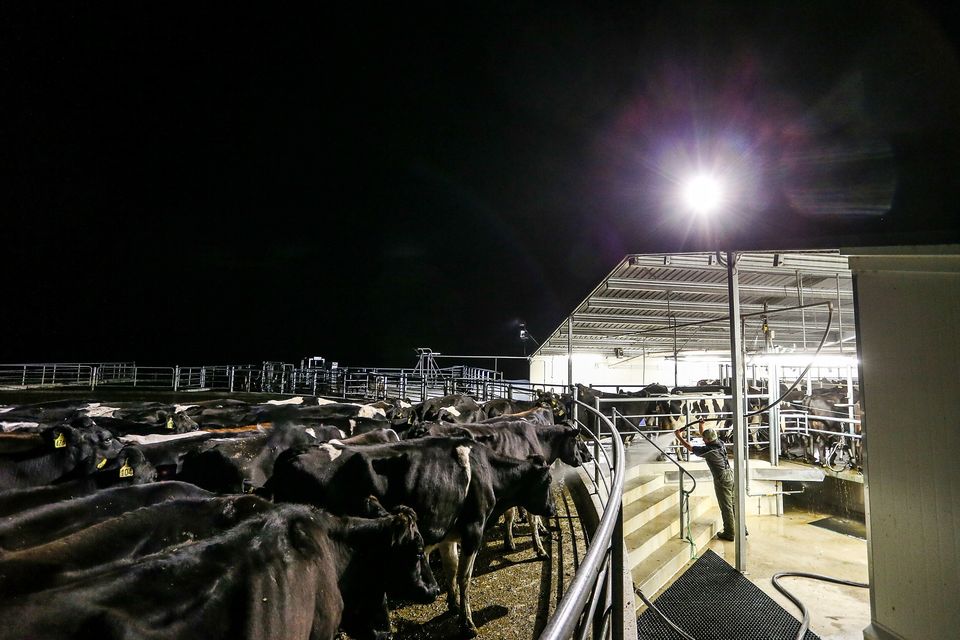
Stronger milk prices and good weather have seen many dairy farmers drive on milk production this autumn.
While many dairy farmers have taken advantage of good grass availability over the past month, dairy feed sales are also up significantly on last year, with some merchants recording a sales boost as high as 20pc on 2023.
It comes as Lakeland Dairies announced a base milk price of 49.6c/l, Dairygold increased its base by 1.0cpl to 49.0cpl and Kerry Dairy Ireland said it would pay 48.50.
Kerry said based on its average milk solids for October, the milk price return inclusive of VAT and bonuses is 62.82c/l.
Noel Murphy, Chairperson of ICMSA Dairy Committee, told the Farming Independent that some farmers “are delaying their ‘dry-off’ period and milking on that little bit extra”.
“Farmers are making a margin from milking on. It is attractive for farmers to milk on, possibly into the end of the month — 2024 is one of those years where you can milk on because of milk price and that extra grass growth we did not get in the summer,” he said.
“In a typical year, farmers would tend to dry off their younger, first-calvers, and cows that would need an extra-long dry period, more than the typical eight weeks, from the start of November.
“However, farmers are conscious that if they milk on from now onwards, they may not be able to get out as early next spring depending on growth rates.”
Mr Murphy added that weather has been “a tonic” for farmers this autumn, which “contrasts favourably” with the pressures faced in spring and early summer.
He said grass growth is “good”, and farmers are making the most of “what grass they have now while they have it”.
“Temperatures are high for this time of the year. It is unusual to see grass growing as good as it is for this time of the year.
“We had a tough spring, coming out of a bad autumn last year, coupled with very high costs this year. It was a difficult year up to August when markets started to move, and prices rose.
“Farmers have fed a lot more concentrates to compensate for the lack of grass growth. Some farmers did not get the usual, expected response from fertiliser given the temperatures.
“There doesn’t appear to be any great increase in ration prices. Farmers have fed more than they would have in other years. Some mills have told us that they have had one of their busiest summers in years.
“Cull cow price is positive and moving in the right direction. That is something farmers would be looking at and taking out non-performers.
“You would still imagine for the year that your average price would be 44-45c/L, which is difficult enough when you see the average production cost of 40-42c/L.
“We would expect early 2025, for the first three months, on foot of the lack of milk supply, to be positive from a market perspective. There is good demand for milk.”
The Farming Independent contacted three merchants, with all reporting dairy feed sale increases.
Pat Ryan of Liffey Mills reported: “I estimate that our dairy feed sales are up around 20pc compared to last year.
Since July, we have seen an increase in particular and feed sales have remained very strong.
“We have been operating at winter tonnage for the last four months, with dairy sales being the main driver, on the back of current milk prices.”
“Last year, cows were all dried off at this stage, but this year, some farmers milking cows later because of favourable conditions.”
Jeremy McGonigle, technical sales director at Smyths Daleside, said: “We have seen a circa 10pc increase in dairy feed sales. I believe this is down to a difficult summer and farmers milking cows for a little longer than usual because of a better autumn weather-wise and grass growth.
“Milk prices are a big variable. Farmers are carrying on cows for a while longer and feeding a little bit extra at the moment.”
Michael Burke, head of operations at J Grennan & Sons, commented: “Farmers are milking on for two reasons – to increase profitability and improve cash flow.
“We are seeing an increase in dairy feed sales. We are notably busier than the corresponding period in 2023. This time last year, a lot of farmers had decided to dry off stock.
“This year, with the weather being so good, many farmers had ample grass up to a week ago. They are milking cows on for longer. Coupled with milk prices, it is paying them to feed on.”
You can now read the most important #news on #eDairyNews #Whatsapp channels!!!
🇺🇸 eDairy News INGLÊS: https://whatsapp.com/channel/0029VaKsjzGDTkJyIN6hcP1K

























